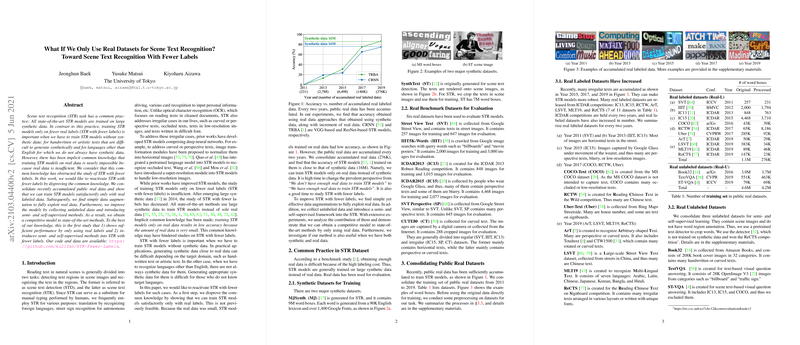Analyzing the Efficacy of Using Only Real Datasets for Scene Text Recognition
This paper investigates the implications of training scene text recognition (STR) models exclusively on real-world datasets, with an emphasis on reducing the reliance on synthetic data. The authors present a novel perspective in the STR domain by challenging the long-held assumption that training solely on real data is unviable due to limitations in data availability.
Overview of the Approach
The paper positions itself against the conventional practice of using vast amounts of synthetic data to train state-of-the-art STR models, citing the scarcity of synthetic datasets for non-English and highly stylistic text domains. To address this, the authors consolidate a comprehensive collection of real labeled data, comprising 276K images from 11 datasets. They propose enhancing model performance through data augmentation techniques, as well as utilizing semi- and self-supervised learning methods on an additional 4.2M unlabeled real images.
Main Contributions
- Sufficient Real Data Compilation: The authors argue and demonstrate that the accumulated real labeled data is now sufficiently large to train STR models with competitive accuracy to those trained on synthetic datasets. Both CRNN and TRBA models, when trained solely on this real data corpus, achieved accuracies close to those obtained with synthetic data.
- Data Augmentation Techniques: By applying simple augmentations like Blur, Crop, and Rotation, the paper reports significant improvements in STR performance, particularly when augmenting real data. This highlights how augmentation can be pivotal in optimizing data use.
- Semi- and Self-Supervised Learning: Leveraging techniques such as Pseudo-Labeling and RotNet, the authors incorporate unlabeled data to further boost model performance. This strategy substitutes effectively for synthetic data, offering a viable alternative for enhancing label efficiency in real-world applications.
- Analysis of Data Impact: The paper explores the dynamics of accuracy as a function of the volume of training data. Notably, models trained on a mix of labeled and unlabeled real data achieved accuracy gains, implying that real data diversity can compensate for volume limitations.
- Practical Implications for Multi-Domain STR: The final exploration entails mixing real and synthetic datasets, providing insights into optimizing STR model training to meet application-specific constraints, where real-world data alignment is crucial.
Implications and Future Directions
This research shifts the paradigm towards the feasibility of STR with limited annotated real data, suggesting practical applications like multi-lingual text recognition. The findings imply that substantial real-world data, especially when diverse and augmented intelligently, can challenge synthetic data's dominance in STR training. As STR systems become more deployable across niche domains without needing expert-generated synthetic datasets, this approach could democratize access to robust text recognition solutions.
Future directions may explore deeper semi-supervised frameworks or investigate how minimal labeled real data, when strategically coupled with unlabeled data from relevant domains, can consistently surpass traditional synthetic data methods. Additionally, expanding these techniques to languages with less digital representation could broaden the scope and accessibility of STR technologies globally, fostering further research in STR adaptations and generalizations.
